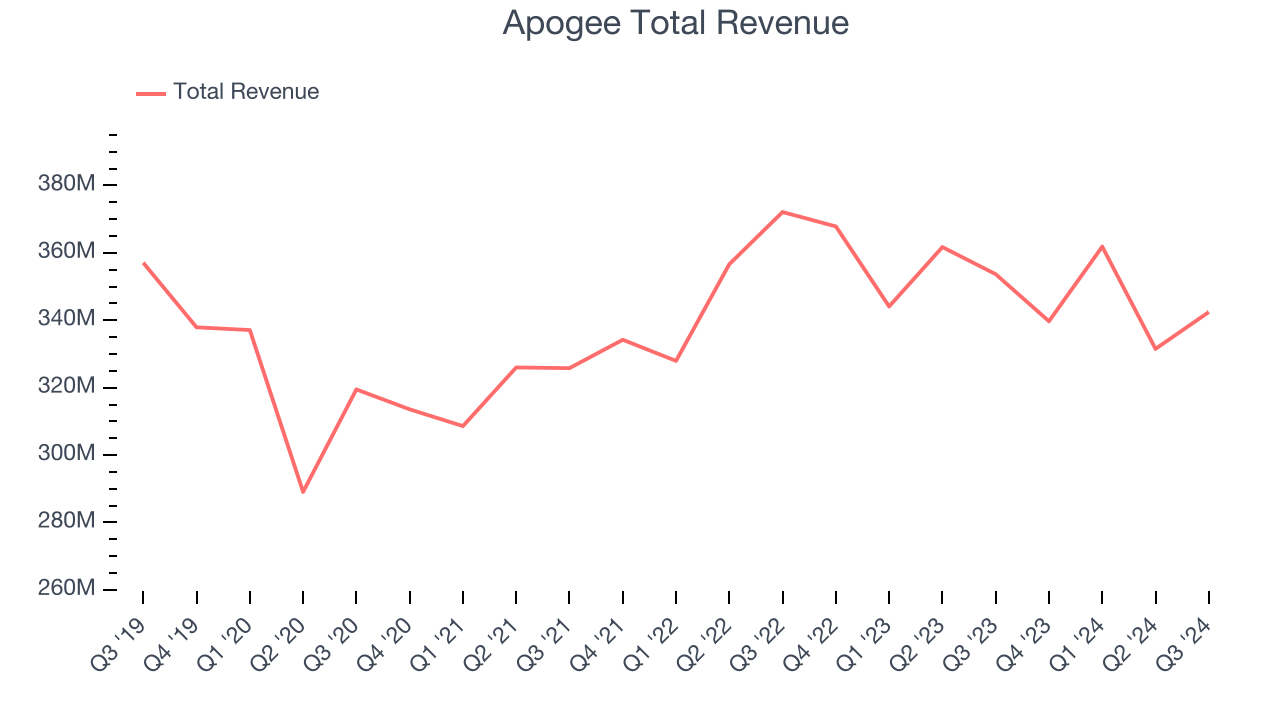Architectural products company Apogee (NASDAQ:APOG) announced better-than-expected revenue in Q3 CY2024, but sales fell 3.2% year on year to $342.4 million. Its GAAP profit of $1.40 per share was also 20.3% above analysts’ consensus estimates.
Is now the time to buy Apogee? Find out by accessing our full research report, it’s free.
Apogee (APOG) Q3 CY2024 Highlights:
- Revenue: $342.4 million vs analyst estimates of $335.6 million (2% beat)
- EPS: $1.40 vs analyst estimates of $1.16 (20.3% beat)
- Gross Margin (GAAP): 28.4%, up from 27% in the same quarter last year
- EBITDA Margin: 15.5%, up from 14.1% in the same quarter last year
- Free Cash Flow Margin: 14.7%, up from 9.5% in the same quarter last year
- Market Capitalization: $1.50 billion
Company Overview
Involved in the design of the Apple Store on Fifth Avenue in New York City, Apogee (NASDAQ:APOG) sells architectural products and services such as high-performance glass for commercial buildings.
Commercial Building Products
Commercial building products companies, which often serve more complicated projects, can supplement their core business with higher-margin installation and consulting services revenues. More recently, advances to address labor availability and job site productivity have spurred innovation. Additionally, companies in the space that can produce more energy-efficient materials have opportunities to take share. However, these companies are at the whim of commercial construction volumes, which tend to be cyclical and can be impacted heavily by economic factors such as interest rates. Additionally, the costs of raw materials can be driven by a myriad of worldwide factors and greatly influence the profitability of commercial building products companies.
Sales Growth
A company’s long-term performance can give signals about its business quality. Even a bad business can shine for one or two quarters, but a top-tier one tends to grow for years. Apogee struggled to generate demand over the last five years as its sales were flat. This is a tough starting point for our analysis. 
We at StockStory place the most emphasis on long-term growth, but within industrials, a half-decade historical view may miss cycles, industry trends, or a company capitalizing on catalysts such as a new contract win or a successful product line. Just like its five-year trend, Apogee’s revenue over the last two years was flat, suggesting it is in a slump. We also note many other Commercial Building Products businesses have faced declining sales because of cyclical headwinds. While Apogee’s growth wasn’t the best, it did perform better than its peers.
This quarter, Apogee’s revenue fell 3.2% year on year to $342.4 million but beat Wall Street’s estimates by 2%. Looking ahead, Wall Street expects sales to grow 2.3% over the next 12 months, an acceleration versus the last two years.
Unless you’ve been living under a rock, it should be obvious by now that generative AI is going to have a huge impact on how large corporations do business. While Nvidia and AMD are trading close to all-time highs, we prefer a lesser-known (but still profitable) semiconductor stock benefitting from the rise of AI. Click here to access our free report on our favorite semiconductor growth story.
Operating Margin
Operating margin is a key measure of profitability. Think of it as net income–the bottom line–excluding the impact of taxes and interest on debt, which are less connected to business fundamentals.
Apogee has done a decent job managing its cost base over the last five years. The company has produced an average operating margin of 8.1%, higher than the broader industrials sector.
Analyzing the trend in its profitability, Apogee’s annual operating margin rose by 7.3 percentage points over the last five years, showing its efficiency has meaningfully improved.

This quarter, Apogee generated an operating profit margin of 12.3%, in line with the same quarter last year. This indicates the company’s cost structure has recently been stable.
Earnings Per Share
We track the long-term growth in earnings per share (EPS) for the same reason as long-term revenue growth. Compared to revenue, however, EPS highlights whether a company’s growth was profitable.
Apogee’s EPS grew at an astounding 23.8% compounded annual growth rate over the last five years, higher than its flat revenue. This tells us management responded to softer demand by adapting its cost structure.

Diving into the nuances of Apogee’s earnings can give us a better understanding of its performance. As we mentioned earlier, Apogee’s operating margin was flat this quarter but expanded by 7.3 percentage points over the last five years. On top of that, its share count shrank by 18.2%. These are positive signs for shareholders because improving profitability and share buybacks turbocharge EPS growth relative to revenue growth. 
Like with revenue, we analyze EPS over a shorter period to see if we are missing a change in the business. For Apogee, its two-year annual EPS growth of 39.4% was higher than its five-year trend. We love it when earnings growth accelerates, especially when it accelerates off an already high base.
In Q3, Apogee reported EPS at $1.40, down from $1.52 in the same quarter last year. Despite falling year on year, this print easily cleared analysts’ estimates. Over the next 12 months, Wall Street expects Apogee’s full-year EPS of $4.75 to shrink by 4.3%.
Key Takeaways from Apogee’s Q3 Results
We were impressed by how significantly Apogee blew past analysts’ EPS expectations this quarter. We were also excited its revenue outperformed Wall Street’s estimates. Zooming out, we think this was a solid quarter. The stock traded up 4.3% to $71.35 immediately after reporting.
Sure, Apogee had a solid quarter, but if we look at the bigger picture, is this stock a buy?We think that the latest quarter is only one piece of the longer-term business quality puzzle. Quality, when combined with valuation, can help determine if the stock is a buy.We cover that in our actionable full research report which you can read here, it’s free.
